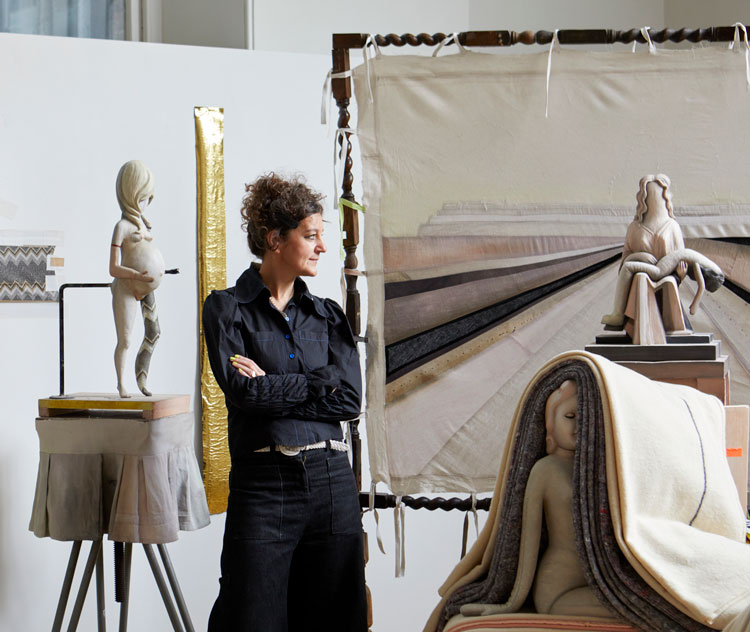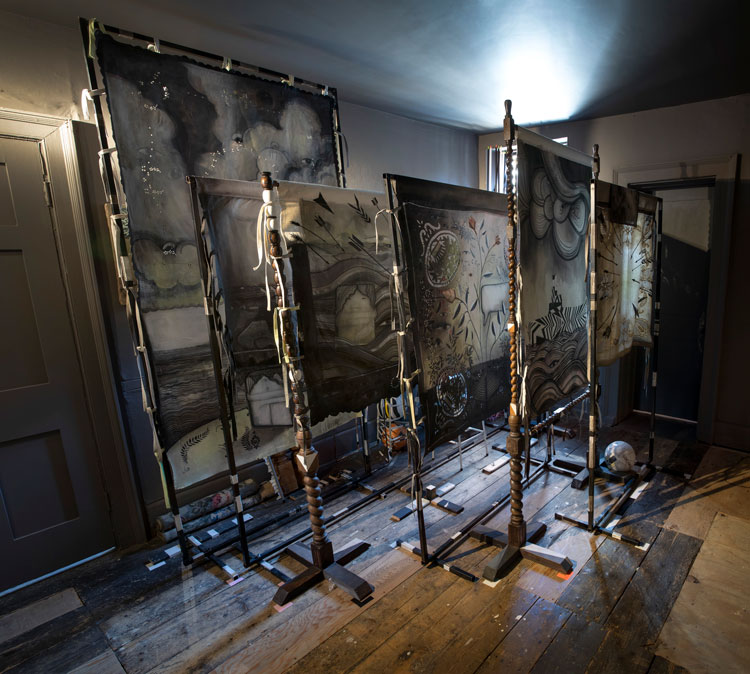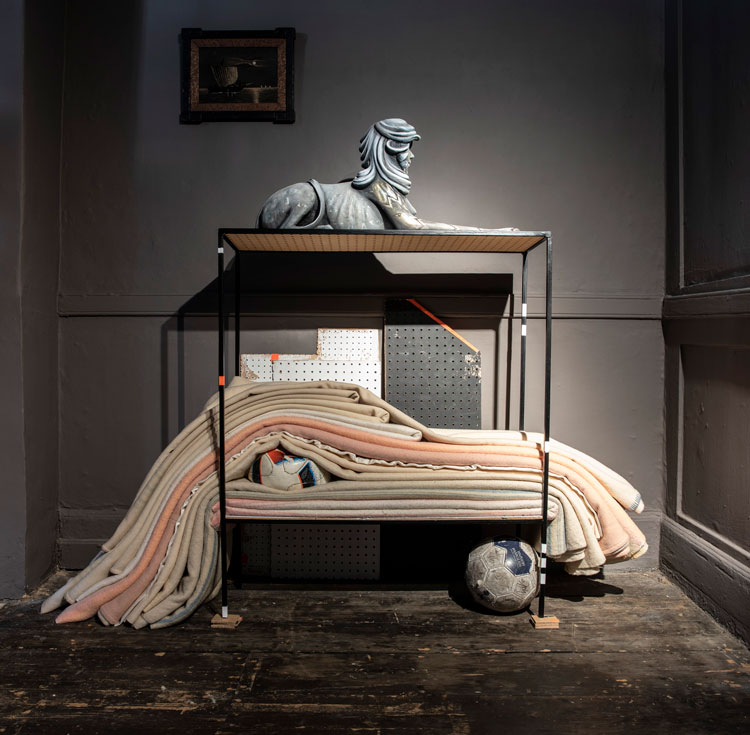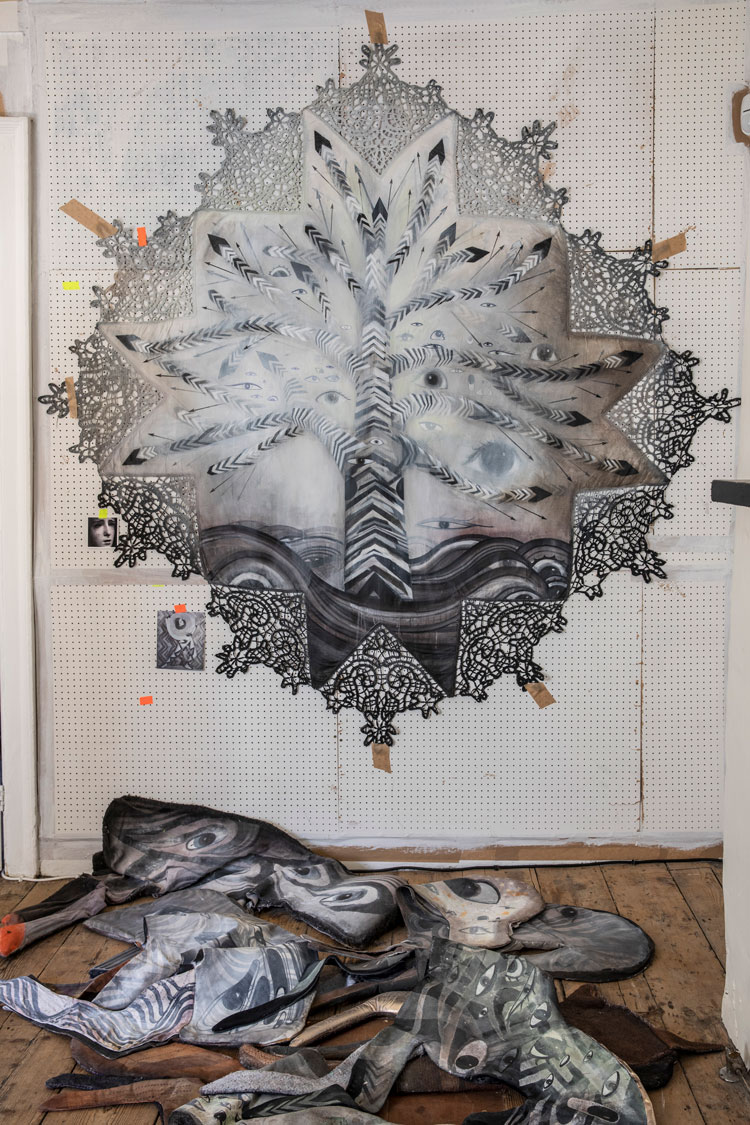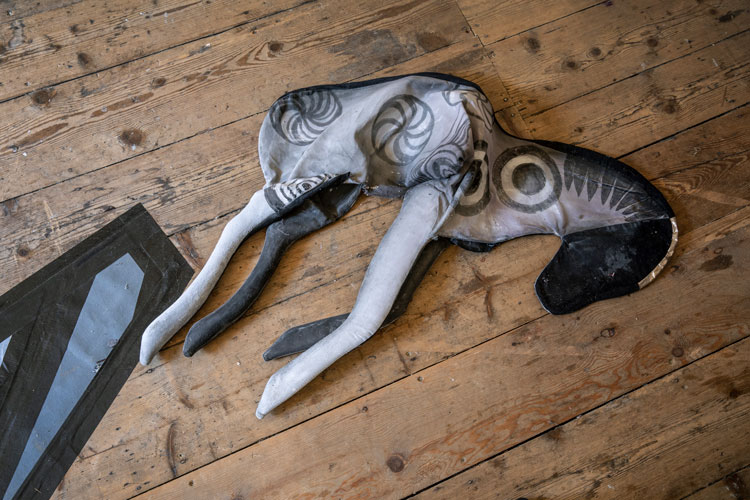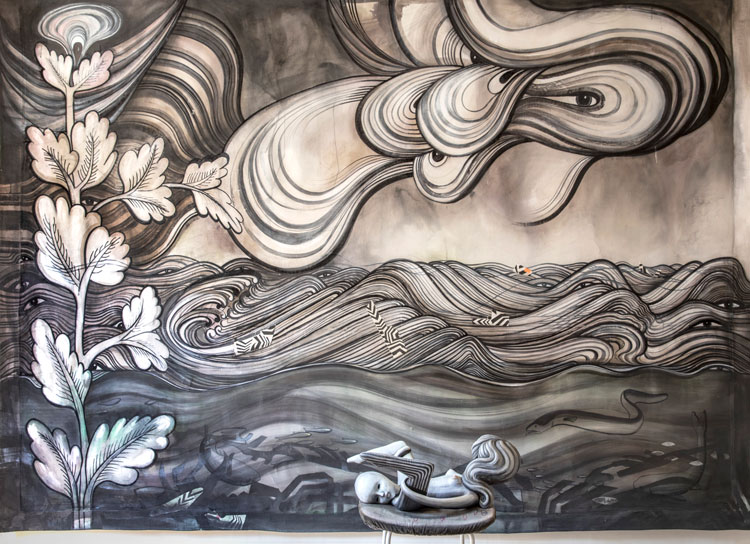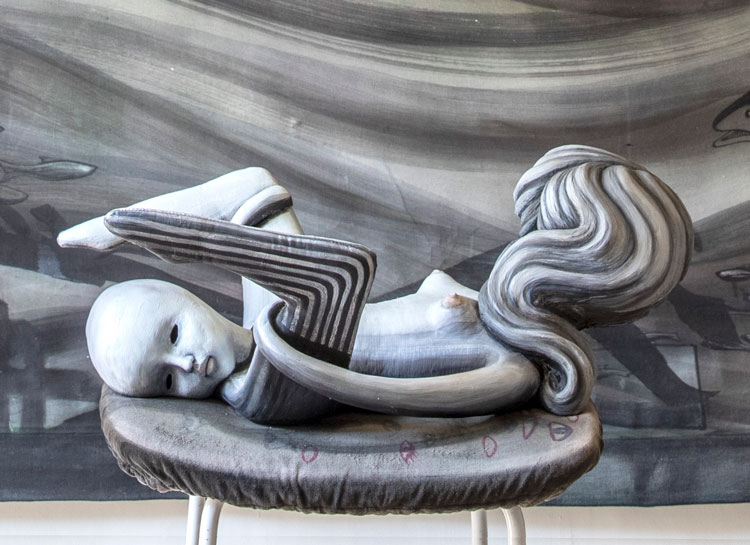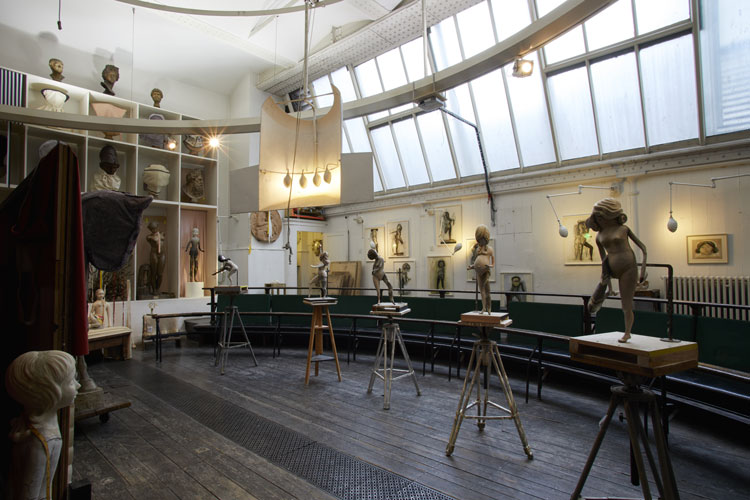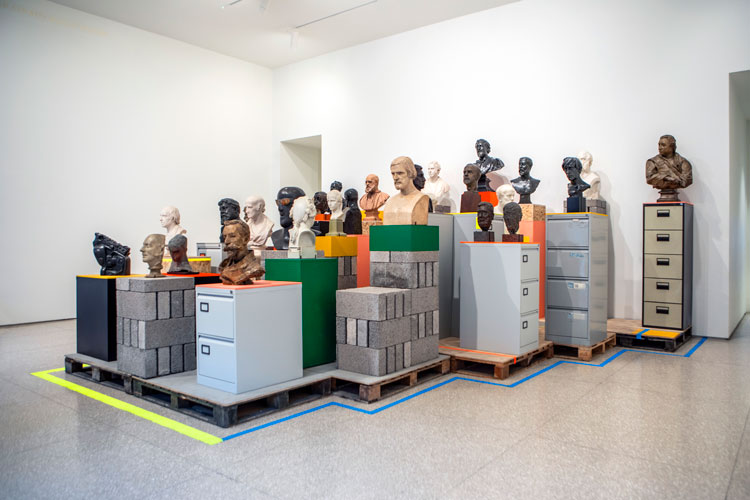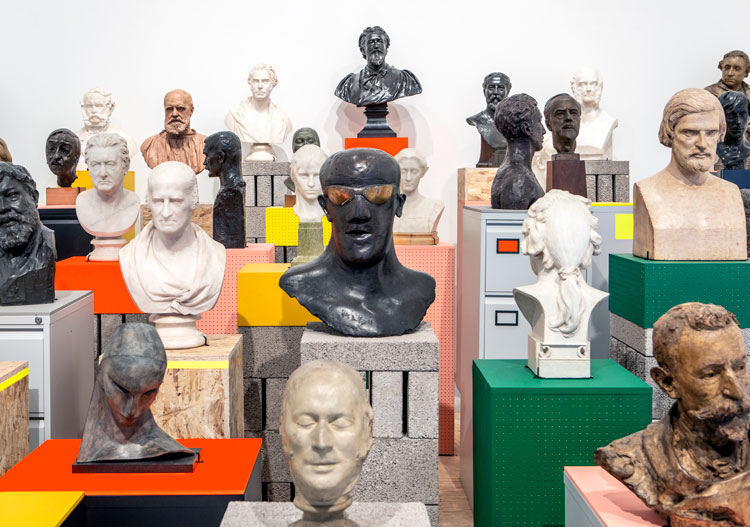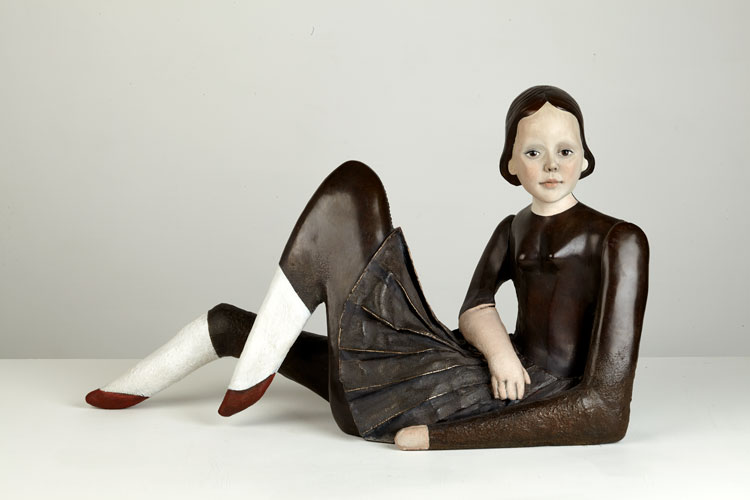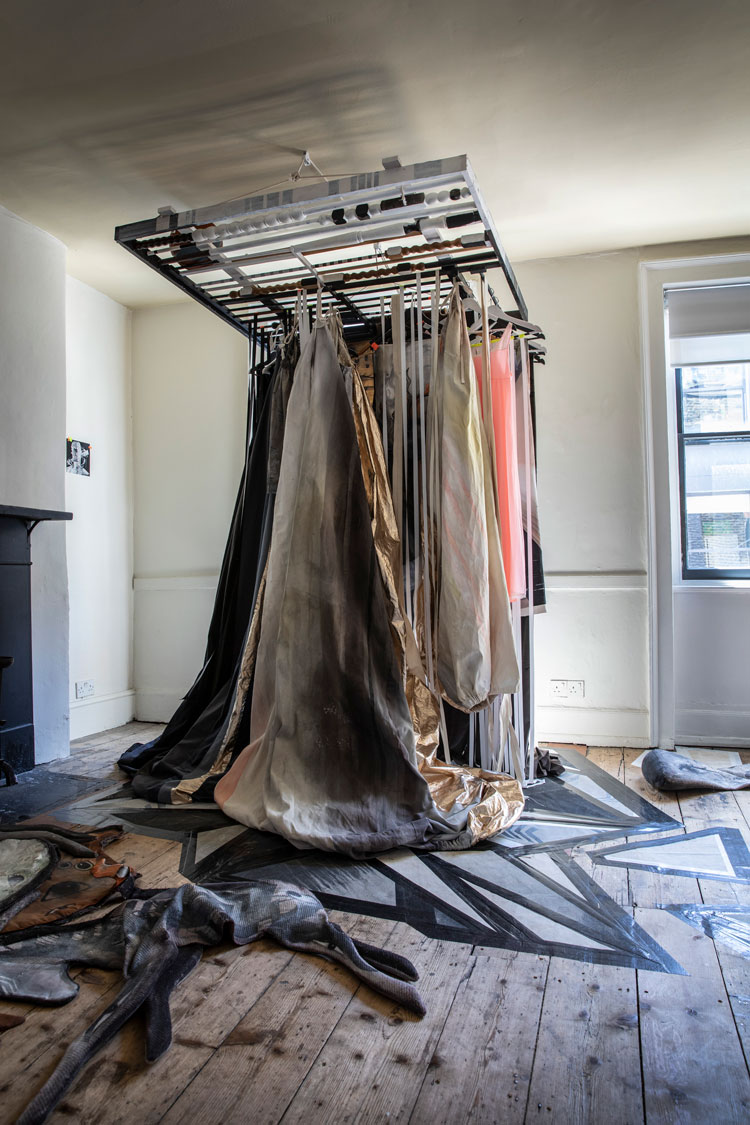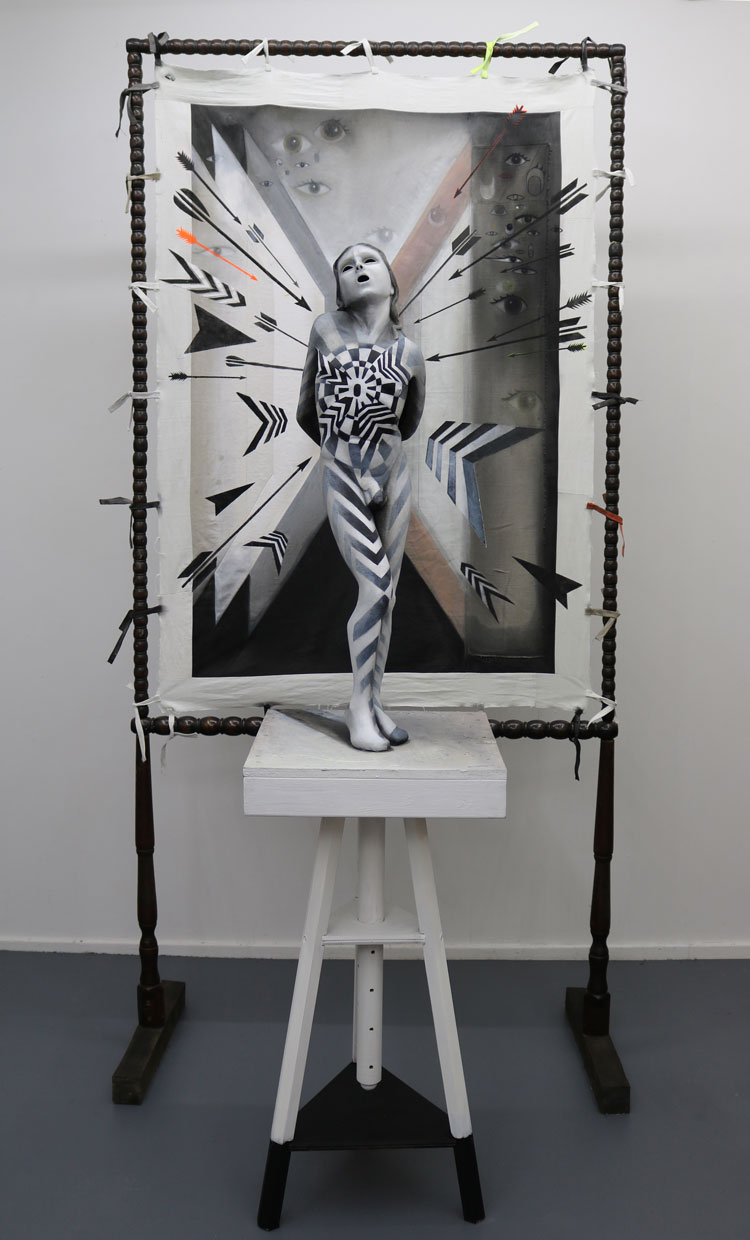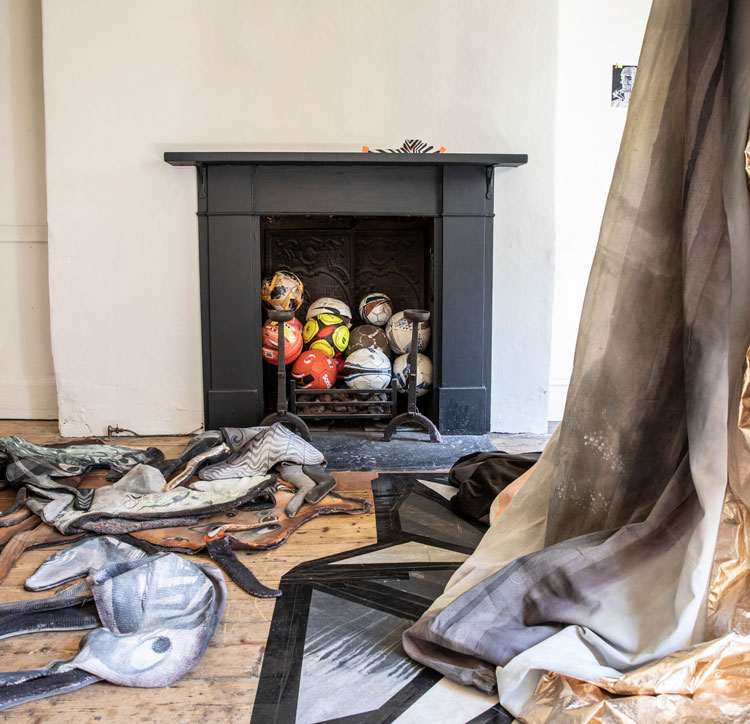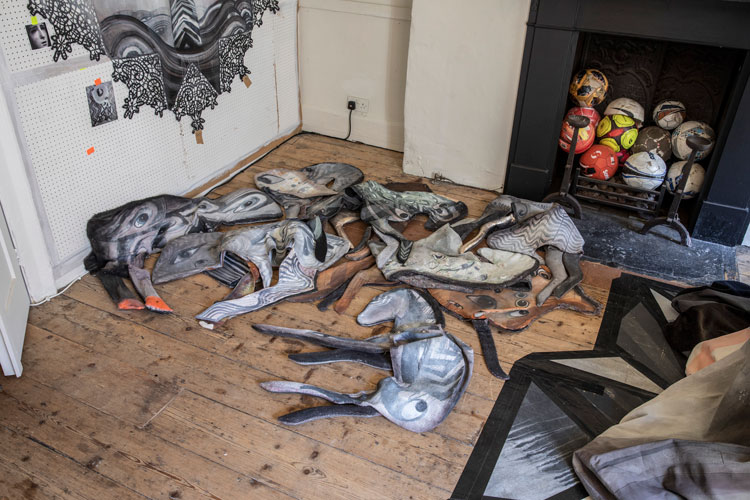

by ANNA McNAY
Cathie Pilkington (b1968, Manchester) is known for her surreal and uncanny work, frequently displayed in domestic settings, employing her trademark bricolage dolls, and the use of fabric and found objects, to create immersive settings, in which things are never quite as they seem, and viewers are forced to repeatedly circle back on themselves and look again.
[image2]
For her current exhibition at Karsten Schubert in London, entitled Estin Thalassa (“behold the sea”), Pilkington has taken epic motifs relating to apocalypse and disaster, as well as found objects – such as masking tape from her studio and deflated footballs – and fabric, on which she has drawn with felt-tip pen. Picking up on theoretical concepts from the work of Anton Ehrenzweig (1908-66), a theorist and Goldsmiths lecturer, Pilkington questions the boundaries between mediums, genres and even one work and the next. She also reflects on her own position within the (patriarchal) history of sculpture – especially in light of her new role as Keeper of the Royal Academy Schools.
Pilkington spoke to Studio International in the run up to the installation of her exhibition.
Anna McNay: The working title for your exhibition was The Flood, which ended up being changed to Estin Thalassa, meaning “behold the sea” (with “Thalassa” being the primeval spirit of the sea in Greek mythology). These words were also the inscription held by the naked female form in Eric Gill’s first stone figure carving from 1909. You confronted Gill’s work directly when you had an exhibition in response to it at Ditchling Museum of Art + Craft, in 2017. Was this title chosen with reference to him? Can you talk a little about the titular choice, its meaning and implications?
Cathie Pilkington: Yes, you are right to make that connection with the Gill sculpture. When I started making work for this show, I had an overall epic theme in mind. My previous project, in collaboration with Marion Adnams at Transition Gallery, was called Strange Coast, and there are a lot of things from that project which have returned – almost like things coming back with the tide; the way that found objects accrue in the studio, and the way that one project folds into the next. I have got to a point with my practice where I no longer try to demarcate one project from the next; they grow into each other. Strange Coast developed out of my intervention at Pallant House Gallery (Working from Home, 2018-19), and Estin Thalassa feels like the sequel to The Covering, which was my last show in Karsten Schubert Gallery’s Room Two at the start of lockdown – but this body of work has a hysterical, overblown and epic theme, which resonates with what’s going on in the world.
[image15]
Initially, I had the working title of The Flood, which referenced the very straightforward biblical narrative of apocalypse, disaster and the overwhelming power of nature. I quite often collaborate with [art historian] Neil Walton, who writes texts for my work [including to accompany this exhibition], and we have this chatty, critical relationship. He knows me and my work well, so it’s an interesting way of framing what I’m doing and digging deeper as I go. We started talking about looking at this show from another perspective – a more psychoanalytical perspective – rather than framing the very obvious epic narrative. We have both been reading this quite obscure work by Anton Ehrenzweig, The Hidden Order of Art, published posthumously in 1967. He had worked on it for about 12 years, and it develops some of the ideas from Freud’s writings, such as that of the oceanic state. The way I work is thematic. Things interconnect. But I take all these ingredients to a specific situation, and then something new happens, so it’s complicated trying to write about it before the show, because there is only so much of it that is pinned down. Neil was interested in the idea that there is a pathological resistance on my part to finalising the work. I think he’s probably right! When you finalise a work, there’s a death of possibility. It’s this, not that, and I always want to keep things open. I want to keep the conversation going.
[image6]
AMc: At what point did you change the title?
CP: Quite last minute, typically. The show is complex and multilayered, and I felt The Flood was far too simplistic and biblical. Estin Thalassa is the title of one of the pieces in the show – the little figure giving birth to itself. As I worked, this piece became emblematic of all the things I was talking about, and it felt the right thing to name the whole show after it. It’s more enigmatic, I love how it sounds, and it’s great to have a title that makes people think.
AMc: Thalassa is a spirit of the sea.
CP: Yes, in Greek mythology, Thalassa is the spirit of the sea, but the sea is also a metaphor for the unconscious, and Estin Thalassa, as you said, means “behold the sea” or “there is the sea,” and it is used in Clytemnestra’s speech, just before she murders her husband Agamemnon, in Aeschylus’ play [also called Agamemnon]. It’s called the sinister soliloquy, and it starts off: “There is the sea – and who shall drain it dry? – […] it knows no poverty.”
It is about overwhelming tidal forces you can’t do anything about, and when Gill used the phrase to title his first figure carving, I think he was talking about overwhelming forces as well: creativity and his insatiable libidinous drive. He wrote in his diary: “I wanted a woman, and I couldn’t have a woman” – his wife was pregnant at the time, and so he couldn’t have sex with her – “so I made flesh out of stone so I could have my woman.” Like Pygmalion – the god-like creator. I love all those connections – there is always the tension of animate and inanimate object when you are making figurative sculpture. I work instinctively, in a stream of consciousness. You have to pull out of that Dionysian mania to make critical decisions, but then you can’t stay in that place either, you have to move in and out of those states, so it seemed to work on every level to call the show Estin Thalassa. I enjoy titling things. It’s good fun, because you can be obscure; you can obfuscate things or make connections that are personal, but hidden at the same time. It’s just like making an object, really, isn’t it? Making a title.
[image5]
AMc: Tell me a bit about the work in the exhibition as a whole. It is a fairly claustrophobic two-room installation in an old boho Soho townhouse – something very recognisably Pilkington, since you frequently work in intimate, domestic spaces, dealing with that collision between the home and the wider world, and frequently with a sense of confinement and overspilling.
CP: It’s an amazing building. It’s really dilapidated, so going up the stairs almost becomes part of the show, which I love. It feels like a space I want to work in and inhabit, but it is also very basic. There are no lights, just two quite beautiful, shabby rooms. It’s called Room Two, and it was Karsten Schubert’s apartment to get away from the office. He hadn’t had it very long before he died, and he was very excited about opening it as a project space, so it’s lovely that the gallery is using it in the way it is. It feels exciting. We talk about the two rooms as “the dark room” and “the light room”, because, in the front room, there are two big windows, so you get a lot of direct sunlight, but, in the back room, it’s very dark, with just a tiny window and a spotlight.
The work in there – I can’t call it “drawing” or “painting” because it’s neither – or both! – so let’s say “flat work” or “fabric works” – it blurs the boundaries between objects and painting. I was trying to make more two-dimensional work on found cloth, so, instead of approaching it as a stretcher with oil paint, I started working on things such as antimacassars, bedspreads and old curtains, which already had a history. I just drew directly on to them with felt-tip pen. It was a deliberately low-grade, colouring-in attitude. I started doing these works during the first lockdown, and they were all images of weather and sea. They were patterns more than pictures. I was nailing them directly on the wall and drawing on them, and, when I pulled them off, they became almost like studio laundry. I use a lot of printmaking marble drying racks in the studio, so I was hanging up the fabric works and treating them like laundry rather than pictures. They turned into the screens, because I wanted them to be freestanding, where the back view is as important as the front. The frames are made from found furniture. They have this ecclesiastical feeling; like crusade banners, a bit desperate, cobbled together and handmade, but functional.
[image4]
AMc: It is hard to tell from the installation images, but is the sea also drawn directly on to the gallery wall, or is that fabric as well?
CP: That’s a huge piece of velvet. I made that work in my tiny studio in east London, and it’s the same size as the studio wall, so it was the biggest picture I could possibly make there. It was lockdown, and I was doing my new job [as Keeper of the Royal Academy] on Zoom. I am used to it now, but I had never even had a Google Calendar, and I am one of those people who is pretty phobic about working on a computer, so I was doing this drawing to channel my difficulties and frustrations. It was a direct way of working and very exciting. I tend to work across everything all at once, so I was painting the objects and the banners at the same time. Then I stop and question what the difference is between an object and a sculpture and a picture and a painting, and I love that whole democracy of things, which is why I work the way I work. I don’t want the work to begin and end. I don’t want to say one thing is more important than the other. And that has interesting connections with Ehrenzweig’s idea of “dedifferentiation”. He talks about the creative process as being a kind of manic oceanic state, where you think anything is possible, and, within that period of time, you are out of focus, everything is fuzzy, but you’re highly attuned to things. You could say that’s the stream of consciousness, where there is no difference between where one thing begins and the other one ends. I was painting the pictures and the objects as if they were the same thing. The object disappears into the picture and the patterns and the repeating rhythmic motifs, such as the eyes, which appear everywhere, in the sky, in the sea and on the objects.
Ehrenzweig’s lingo makes sense of what I have long been doing. His other great word is “poemagogic”, which is the idea that the end product, or the artwork when it is finalised, still bears witness to all those stages of fragmentation and re-introjection – it’s a cycle. In the same way, the Estin Thalassa figure is both a birth and a rebirth. It’s almost like an emblem of the creative process – the artist giving birth to themselves. The doll has a completely blank face, but the baby is looking at you with ancient eyes. All the other objects in the exhibition have eyes that are hollow and void. There are eyes on every surface. It implies that all the material is animated, every part of the show has a life.
[image7]
AMc: Can I just pick up on your referring to the mother figure in Estin Thalassa as a “doll”? She is not really a doll, as such, in the sense of your usual trademark dolls, which you have previously described as “fantastic, potent things” and a kind of “device”. These are fairly absent in this installation. Why?
CP: They are not as central as they have been in the past few years, no, but that is because this is all new work, and things move on. There is definitely more of an emphasis on the screens, on the drawing, and on the use of fabric. The two main sculptures in the show are Estin Thalassa, the tiny but potent birthing scene, and then Girl’s World (2021), which is a sphinx-type figure. This is constructed in a very similar way to, say, the Degas Dolls from 2014, so it’s a very well-established method of production for me. It continues my passionate attachment to traditional, sculptural studio procedures, such as modelling in clay and casting. Naturalistic representation is often interrupted by body parts made of fabric, which often have intentionally simplified forms reminding you of toys rather than classical sculpture. It’s a kind of bricolage – an assemblage of forms and ideas, which means I can tackle complicated subjects with ambivalence.
[image3]
Girl’s World is based on my 15-year-old daughter Chloe – it’s an object that captures the strange, in-betweenness of being a teenager, of “becoming”. I am combining a reference to a 70s hairdressing toy/bust with an elegant, mythic, ancient beast. It’s not disconnected from the dolls, it’s just a slightly different take. And I would still describe the Estin Thalassa piece as part of that genre, too. One of the things I was looking at while I was making it was the Louise Bourgeois drawing, Untitled (woman giving birth) (1941), which is very like a Sheela na gig. I quite often refer to a drawing and make it into a sculpture and vice versa. I love revisiting established themes and resuscitating those ideas.
[image8]
AMc: That must be one of the advantages of working with your dolls, as opposed to working with marble sculpture – you have that freedom to remake things as you want.
CP: Yes, and it has a completely different cultural direction as well. It’s not classical, it’s not about academic anatomy, and it’s not hierarchical. Obviously, the doll is something that has been used again and again throughout surrealism and contemporary art. Ideas like those of Hans Bellmer, of the body as a sentence you can rearrange and take the limbs off, there is a lot of freedom there. Everyone has that memory of the dolls they played with and undressed to see what their genitals were like. What kind of ideas of the body do they portray? What assumptions do they make about the person who is playing with the doll? Who designs them for whom? It is a really rich and interesting field, so it was great to bring those questions about figuration and sculpture to the life room at the RA Schools [Pilkington had an exhibition, Life Room: Anatomy of a Doll, there in 2017], especially showing the Degas Dolls in relation to the classical casts. I also think that scale is really political – by working quite small, most of the time, I suppose it’s me choosing to have an intimate conversation instead of addressing a museum audience.
[image9]
When I do scale things up, it’s about an accumulation of stuff – it becomes an immersive installation. Another example of this tendency was The Ancestors installation at the Royal Academy, which I worked on with Alison Wilding, and which was a re-presentation of historical busts from the RA Collection. We so readily accept this strange sculptural mode as normal, when actually they are heads with their arms cut off, and they become so odd if you look at them literally. The idea of skin colour is another one, because you don’t assume, if something is made from black bronze, that it depicts a black person, or if it’s made from white marble, that they’re white. The history of polychrome sculpture is something I have always been fascinated by. Reclining Doll (2013) is a good example of how these different positions get combined into one object – Henry Moore, Picasso, a doll, bronze, fabric, oil paint, naturalism and modernist body parts, all mixed up and cast into one object.
[image11]
AMc: You just mentioned gender and hierarchy, and this may be a disingenuous question, but do you feel that your art is particularly “feminine”? Would you say it’s recognisably made by a female artist?
CP: Yes. I think it’s one of those things you try to avoid speaking about, because you are tired of talking about it, in, like you say, a generic or obvious way, but everything I do, and everything I question, is interwoven into that conversation, because women think and live – and have lived – in a non-linear fashion. Our experience throughout history is of being ingenious with the small space we have had to operate in. Everything is condensed, complicated and mixed in, and it’s that mixed-in-ness that is what I’m doing with my installations. So, yes, it is entangled, and it is a feminine space, definitely, and I am often making reference to, and pushing against, the male canon of sculpture – which I love and hate at the same time. There is a lot of ambivalence, and I am constantly throwing my toys out of the pram! I want something to be straightforward, to speak clearly – but there is no pure speech, everything is combinatorial. I am always exploring that tension.
AMc: That messiness.
CP: Absolutely. My work is really messy and really precise at the same time. It becomes really precise at the point of the installation being completed. Until then, the whole thing is messy on every level. All the questions are up in the air, all the processes are going on. It’s almost out of control, before it becomes condensed. I plan, and I have quite a strong idea of the installation, but then, when I get into the actual space, it often shifts in unforeseen ways. The screens in Estin Thalassa, for example, are not shown as individual pictures, but are stacked on top of one other, layered, almost as if they were in storage. It’s really contingent and provisional. They became one work called Night Sea Journey (2021). My daughter came to look round and said: “Mum, you’ll have to tell me what you’ve finished and what you haven’t,” and I said: “It’s all finished. This is it.” She spent some time with it, and I started talking to her about the way gym equipment is stacked away at the back of a church hall when it’s not in use, the way things are put to one side and you can peer in and see stuff, almost like museum storage – the way real objects behave in the world rather than art – and she really got it. People have responded to it in that way, too, because it’s awkward as you come in, but awkward in a way that is intentional. As you turn around and look back, then you can see all the accumulated images, but, when you come in, you don’t know where you are, and you feel as if you have walked into an ambiguously strange store cupboard.
AMc: No exhibition of yours that I have been to has ever been something that you walk straight through in a linear progression. There’s always that need to circle back and go around things.
CP: I think this one is even more like that because everything is so interconnected. There are even the animal carcasses in the front room, spread all over the floor, which you have to pick your way around, being careful not to tread on them. They have really impinged on the space. It feels like one complete work made of interconnected parts.
[image12]
AMc: There is tape on the floor as well – like broken shards of glass or demarcations of a crime scene. Can you say a bit about that?
CP: I like the crime scene reference; I hadn’t thought of that. I have been using tape and provisional materials in my installations for years. Usually, the materials are things I use a lot in the studio, like masking tape or the peg board. Some of them have an autobiographical reference, but they are still formal enough to use just as “stuff”. As I said before, I like the democracy of placing the same value on a bronze sculpture or a sculpture made from masking tape. When I build the installations, it’s a case of bringing together all these things I have worked on intensively and making a formal painting or construction from them. Those materials are brought in as armatures to build with. I quite often tape the floor towards the end of the installation to frame the work. Sometimes it helps people to navigate the work through space. I use bits of fluorescent tape as well, to lead the eye around, so there is a formal logic to it. Underneath The Deposition (2021), which consists of a huge laundry or studio drying rack with all this fabric billowing down like wild weather, I think the tape acts like a shadow. The material cascades down vertically, hits the floor and spreads out horizontally with the tape and the animals. This carries the idea of a linear tradition being spread out and made more democratic with space and material and thought. The tape goes from a solid line to being more fragmented, which is interesting because that links back up with the Ehrenzweig idea of fragmentation. Making the installation is like making a whole new work, and I always go through a crisis during the installation, just as I do with every object I make. That’s the darkness and fragmentation before the resolution. So that fragmented tape was an important part in making sense of the whole room. The fabric came down, the tape exploded and The Scattering (2021) came flying off. The crime scene analogy is a good one, because the animals in The Scattering are like dead carcasses strewn across the room. They are made in cloth, densely patterned, and partially filled with plaster, so some of the limbs are solid and some of the heads are very heavy. I love these objects, because they are not fixed, they are drawings and sculptures and toys, but none of these things. You can put them in any position, move their limbs, pile them up, scatter them around … They are very dilapidated and emotive.
AMc: You just mentioned The Deposition, which obviously has religious overtones – or undertones – and you have already mentioned The Flood as the working title with its biblical connotations. Can you say a little about how you work with, or in response to, religion?
CP: Civilisation is built on these big stories and belief systems, and if you refer back to historical art, you are going to come across religious themes, and, of course, they are compelling. They are about survival and life and death. I have always wanted and needed art to be very urgent, a place that you can go to talk about difficult, fundamental issues. I’m not really interested in art that’s just about art. It doesn’t have to be any particular myth or belief system, it just so happens that I was born where I was born, and grew up where I grew up, so Christian stories and fairy stories are the ones I regularly tap into. And there seems to be such a lack of belief in anything right now, so I like using these old structures to talk about that fragmentation. People often say: “Oh, your work is so dark,” but life is so dark. It’s full of darkness and complexity. How can you make anything without acknowledging that? There is also dark humour. And it’s a relief to share the darkness – there is sadness and beauty in the work.
[image13]
Right at the start of the pandemic, I made a sculpture of St Sebastian, called Dazzle (2020). This is a very ambivalent figure. It was at the time when statues were all over the news, being reassessed, toppled and brought down, so it was an interesting time to think about figurative sculpture. The Royal Academy has this amazing history with dazzle ships. During the war, a lot of the dazzle designs were made in the RA Schools by the female students. I have always loved dazzle ships and the idea of the three-dimensional form being taken over by an illusion, a perfect formal device for talking about unconscious fragmentation, but also physical fragmentation. That is one of the reasons this show has developed in such a monochrome way. The arrow motif in the show also developed out of the St Sebastian theme – there is something so compelling about them, so fitting – stuff coming at you from everywhere, a lot of wild weather, and the idea of protection and vulnerability. All these ideas run through Estin Thalassa in the form of patternistic repetition, like the margins of medieval illuminated manuscripts.
[image14]
AMc: Your mentioning monochrome just reminded me that I wanted to ask about the footballs in the fireplace, as well, because they are pretty much the only splash of colour in the show.
CP: They are a discussion point, aren’t they? When I was making the show, my husband started to find these old footballs while walking our dog, so we started to collect them. They are really beautiful. Basically, they are just fucked! Completely worn out. They are a found-object equivalent to The Scattering. It’s as if they have been brought in by the tide to become part of the work. They are dilapidated and empty, but, instead of being handmade, they are manufactured. They became this really interesting counterpoint, which is the way I use all the found objects in my work. Ironically, I’m not a football fan, but old footballs are lovely. They work on so many different levels. When we started the installation, I put them in the fireplace as a provisional holding pen, but then I made the decision to keep them there. That’s a good example of the kinds of things that happen on site. They also appear in Girl’s World, in a very precise way, pressed between the multilayered stacks of blankets. They turn up here as these ambivalent, suggestive objects that have something to do with sleep, death, burial, memory and boys. And my grandma’s laundry cupboard.
AMc: Again, something very domestic. What is it about the domestic that appeals to you in your work?
CP: The convention of the contemporary white-walled gallery space is a space that is elevated from our real lives – insulated from life. The ideas of integration and democracy, which I’m so interested in, happen much more readily in other kinds of spaces. Not just domestic spaces, but spaces that are like found objects, which bring with them a history and content that you have to take on and reckon with in some way. An extreme example of this is the Royal Academy life room, which I worked with in 2015 – how to deal with the baggage of all that history and exclusion? It’s also an interest in the sculptural dilemma of sharing the physical world with us instead of having its own protected, “framed” space on the wall, like paintings. Plinths, for example, are a bit like coat hangers. If you look at the Royal Academy Summer Exhibition, sculpture has this terrible problem, because it can’t get hung on the wall and it can’t float. It ends up in its own room, which looks like a room full of boxes with knick-knacks on top. By using plinths, the curators are trying to isolate the sculptural object, but it ends up looking like a bric-a-brac sale. This really interests me.
AMc: Finally, since you mention the Royal Academy again, can you say a little about your role as Keeper, which you took on last year, having already been a professor of sculpture since 2016? How do these roles fit within – or alongside – your practice?
CP: Becoming a Royal Academician and having to interface with that history has sharpened certain aspects of my practice. The life room installation is an example of that. I am always asking: who am I in this context, within this history? It’s a place where traditional, modern and contemporary art are constantly in conversation with each other. The RA Schools are unique. Our student numbers are small, and we have great studio spaces. It allows us to work very closely with individuals to facilitate their development. It’s been a very strange time for me to start the job as Keeper. I don’t really feel that I’m properly in the job yet, because most of it has been on Zoom, and it’s felt strangely remote. The Royal Academy is the oldest artist-run space in Europe, and it still operates with artists as the governing body. We get no government funding, but still maintain our independent art school and offer students three years’ postgraduate education with no fees. They get time to really think and make brave, uncompromised decisions about their work. I don’t think there is anywhere else like it – it’s precious, and I’m determined to protect it. That’s why I love the title “the Keeper”.
• Cathie Pilkington: Estin Thalassa is at Karsten Schubert, London, until 9 July 2021.
